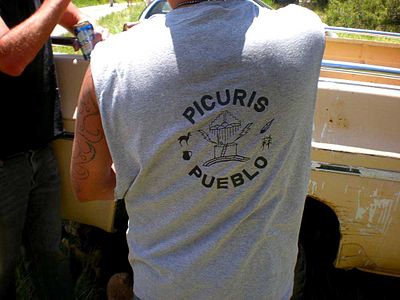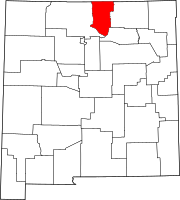Picuris Pueblo, New Mexico
Picuris Pueblo, New Mexico | |
|---|---|
 San Lorenzo de Picurís | |
 Location of Picuris Pueblo, New Mexico | |
| Coordinates: 36°12′9″N 105°42′42″W / 36.20250°N 105.71167°W | |
| Country | United States |
| State | New Mexico |
| County | Taos |
| Area | |
| • Total | 0.46 sq mi (1.19 km2) |
| • Land | 0.46 sq mi (1.18 km2) |
| • Water | 0.00 sq mi (0.01 km2) |
| Elevation | 7,323 ft (2,232 m) |
| Population | |
| • Total | 83 |
| • Density | 181.62/sq mi (70.17/km2) |
| Time zone | UTC-7 (Mountain (MST)) |
| • Summer (DST) | UTC-6 (MDT) |
| Area code | 505 |
| FIPS code | 35-56810 |
| GNIS feature ID | 0928771 |
Picuris Pueblo | |
 Location of Picuris Pueblo and neighboring pueblos in New Mexico | |
| Nearest city | Taos, New Mexico |
|---|---|
| Area | 20.4 acres (8.3 ha) |
| Built | 1776 |
| Architectural style | Pueblo |
| NRHP reference No. | 74001211[3] |
| NMSRCP No. | 229 |
| Significant dates | |
| Added to NRHP | August 13, 1974 |
| Designated NMSRCP | December 30, 1971 |
Picuris Pueblo (/pɪkəˈriːs/; Tiwa: P'įwweltha [p’ī̃wːēltʰà]) is a historic pueblo in Taos County, New Mexico, United States. It is also a census-designated place (CDP) and a federally recognized tribe of Native American Pueblo people. The 2010 census[4] estimated that 68 people lived in the CDP, while 267 people in the U.S. reported being of the tribal group Picuris alone[5] and 439 reported being of the tribal group Picuris alone or in combination with other groups.[6] Picurís Pueblo is a member of the Eight Northern Pueblos. Their own name for their pueblo is P'įwweltha, meaning "mountain warrior place" or "mountain pass place." They speak the Picuris dialect of the Northern Tiwa language, part of the Kiowa-Tanoan language family.[7]
Geography[edit]
Picuris Pueblo is located in northern New Mexico,[8] on the western slopes of the Sangre de Cristo Mountains and 18 miles south of Taos Pueblo. Average elevation in the pueblo is over 7,000 feet.[7]
According to the United States Census Bureau, the CDP has a total area of 0.4 square miles (1.0 km2), all land.
Demographics[edit]
| Census | Pop. | Note | %± |
|---|---|---|---|
| 2020 | 83 | — | |
| U.S. Decennial Census[9][2] | |||
As of the census[10] of 2000, there were 86 people, 38 households, and 18 families residing in the CDP.[11] The population density was 192.7 inhabitants per square mile (74.4/km2). There were 60 housing units at an average density of 134.4 per square mile (51.9/km2). The racial makeup of the CDP was 10.47% White, 70.93% Native American, 16.28% from other races, and 2.33% from two or more races. Hispanic or Latino of any race were 26.74% of the population.
There were 38 households, out of which 10.5% had children under the age of 18 living with them, 21.1% were married couples living together, 13.2% had a female householder with no husband present, and 52.6% were non-families. 42.1% of all households were made up of individuals, and 13.2% had someone living alone who was 65 years of age or older. The average household size was 2.26 and the average family size was 3.33.
In the CDP, the population was spread out, with 16.3% under the age of 18, 10.5% from 18 to 24, 30.2% from 25 to 44, 24.4% from 45 to 64, and 18.6% who were 65 years of age or older. The median age was 43 years. For every 100 females, there were 95.5 males. For every 100 females age 18 and over, there were 105.7 males.
The median income for a household in the CDP was $11,528, and the median income for a family was $16,875. Males had a median income of $21,000 versus $23,333 for females. The per capita income for the CDP was $12,492. There were 36.0% of families and 28.7% of the population living below the poverty line, including no under eighteens and 45.0% of those over 64.
In 1990, 147 of the 1,882 enrolled tribal members lived in the pueblo;[7] however, the number reduced to 86 in 2000.[11] At the 2010 Census, the population was recorded as 68.[12] By 2014, it was one of the smallest Tiwa pueblos.[8]
History[edit]
The Picuris people previously lived in an earlier, larger village of about 3,000 people now known as Pot Creek, near Taos. They migrated to the present location along the Rio Pueblo de Taos about 1250 CE.[13] In the 15th century it was one of the largest Tiwa pueblos, influenced by Apache and other Plains Indian cultures, as was the Taos Pueblo.[8][14]
In the late 17th century people from the pueblos of New Mexico revolted against the Spanish colonialists, particularly during a revolt between 1680 and 1696 when they fought for autonomy and their land. Following this period the people of the pueblo were dispersed and had abandoned their pueblo until 1706. At that time they joined with the Spanish to fight against attacks by Comanche and Apache tribes. Then, the Picuris pueblo people settled into a peaceful period.[14]

Spanish explorer Don Juan de Oñate named the pueblo "Pikuria" - which means "those who paint."[8][13] The pueblo was influenced by the Spanish, particularly adoption of Christian religious practices and letting go of traditional rituals and ceremonies.[14] The San Lorenzo de Picurís church was built of adobe by 1776 and was restored in the 21st century.[8][15] Having been influenced by the Spanish and then the Americans for centuries, the Picuris adopted telephone and electrical services, paved roads and television. They resumed their traditional customs, which are performed throughout the year, and became self-governing again in the mid-1920s.[14] As of 2014[update], the pueblo maintained a growing herd of buffalo.[13]
Government[edit]
The Pueblo's headquarters is in Peñasco, New Mexico. Their tribal officers, led by a tribal governor, are elected every two years.[16] In 1991, the tribe opened the four-star Hotel Santa Fe and the Amaya Restaurant, serving Native American cuisine,[17] in Santa Fe, New Mexico.[16]
Education[edit]
The community is in the Peñasco Independent School District.[18]
Tourism[edit]
Located within the Pueblo are the San Lorenzo de Picurís church and the Picuris Pueblo Museum, which displays and sells the works of local weavers, potters and beadworkers.[8] Picuris is particularly known for its micaceous pottery.[16] Excavated dwellings are located within the pueblo. Self-guided tours and permits for photography within the pueblo are available to visitors. Visitors may fish for trout at Pu-La Lake by contacting the Picurís Pueblo Fish & Game and Parks & Wildlife.[8][19] There are also picnic and campground facilities.[13]
Events[edit]
Their major feast day is San Lorenzo's Day on August 10,[16] during which people of all ages engage in races and the Sunset Dance held on August 9.[20] There are Corn Dances and Buffalo Dances in June and August,[14] which may be private ceremonies.[13][20] There are also dances held New Year's Day and in late January and early February that are open to the public.[20]
An Arts & Crafts fair of weaving, sculpture, beadwork, and jewelry is held the first weekend in July.[13]
Notable people[edit]
- Anthony Durand (1956–2009), micaceous potter
- Cora Durand (1902 - 1998), micaceous potter
- Maria Ramita Martinez (1884–1969) micaceous potter
- Joseph Rael (b. 1935), New Age writer
- Rosalie Simbola Aguilar (c. 1898–1947), potter
Gallery[edit]
-
Gerald Nailor, Jr., Governor of Picuris
-
David Gaussoin, Picuris jeweler
-
Picuris ballplayer
-
Performance art by Wayne Gaussoin (Picuris Pueblo), Museum of Contemporary Native Art, Santa Fe, NM, 2009
See also[edit]
- National Register of Historic Places listings in Taos County, New Mexico
- High Road to Taos, New Mexico
References[edit]
- ^ "ArcGIS REST Services Directory". United States Census Bureau. Retrieved October 12, 2022.
- ^ a b "Census Population API". United States Census Bureau. Retrieved October 12, 2022.
- ^ "National Register Information System". National Register of Historic Places. National Park Service. July 9, 2010.
- ^ U.S. Census Bureau (2010). "NM - Picuris Pueblo CDP". United States Census 2010. Archived from the original on August 3, 2018. Retrieved March 8, 2018.
- ^ Census 2010 American Indian and Alaska Native Summary File (AIANSF) - Sample Data, Pueblo of Picuris alone (H47)
- ^ Census 2010 American Indian and Alaska Native Summary File (AIANSF) - Sample Data, Pueblo of Picuris alone or in any combination (H47) & (100-299) or (300, A01-Z99) or (400-999)
- ^ a b c Pritzker, Barry M. A Native American Encyclopedia: History, Culture, and Peoples. Oxford: Oxford University Press, 2000. p. 58. ISBN 978-0-19-513877-1.
- ^ a b c d e f g Picuris Pueblo. Archived 2014-12-04 at the Wayback Machine New Mexico.org Retrieved July 23, 2014.
- ^ "Census of Population and Housing". Census.gov. Retrieved June 4, 2016.
- ^ "U.S. Census website". United States Census Bureau. Archived from the original on December 27, 1996. Retrieved January 31, 2008.
- ^ a b U.S. Census Bureau. "Picuris Pueblo CDP New Mexico" Archived 2020-02-13 at archive.today. 2000. American FactFinder. Retrieved October 27, 2017.
- ^ U.S. Census Bureau (2010). "NM - Picuris Pueblo CDP". United States Census 2010. Archived from the original on August 3, 2018. Retrieved October 27, 2017.
- ^ a b c d e f Picuris Pueblo. Archived 2008-10-10 at the Wayback Machine LaPlaza.org Retrieved July 23, 2014.
- ^ a b c d e Picuris Pueblo. Archived 2007-12-24 at the Wayback Machine Indian Pueblo - 19 Pueblos. Retrieved July 23, 2014.
- ^ San Lorenzo de Picuris. Archived 2013-01-26 at the Wayback Machine LaPlaza.org Penasco. Retrieved July 23, 2014.
- ^ a b c d Pritzker, Barry M. A Native American Encyclopedia: History, Culture, and Peoples. Oxford: Oxford University Press, 2000. p. 61. ISBN 978-0-19-513877-1.
- ^ "Amaya Restaurant." Archived 2014-04-06 at the Wayback Machine Hotel Santa Fe. Retrieved June 28, 2014.
- ^ "2020 CENSUS - SCHOOL DISTRICT REFERENCE MAP: Taos County, NM" (PDF). U.S. Census Bureau. Retrieved July 13, 2022.
- ^ Picurís Pueblo Fish & Game and Parks & Wildlife Archived 2016-03-03 at the Wayback Machine. Taos.gopickle.com Retrieved July 23, 2014.
- ^ a b c Picuris dances. Archived 2016-03-15 at the Wayback Machine Laplaza.org/Penasco Retrieved July 23, 2014.
Further reading[edit]
- John Peabody Harrington (1928). Indian Tales from Picuris Pueblo. Ancient City Press. ISBN 978-0-941270-50-2.
External links[edit]
- American Indian reservations in New Mexico
- Census-designated places in New Mexico
- Federally recognized tribes in the United States
- Native American tribes in New Mexico
- Pueblo great houses
- Census-designated places in Taos County, New Mexico
- Tiwa Puebloans
- Northern Rio Grande National Heritage Area
- Pueblos on the National Register of Historic Places in New Mexico
- National Register of Historic Places in Taos County, New Mexico
- Historic districts on the National Register of Historic Places in New Mexico






